From Conducting Musicians To Conducting Music
The history of the orchestra has been extensively explored from many points of view: the instruments, its size, its role in society and its importance in Western music. `there are many aspects about the ensemble's leadership from a musical, an aesthetic or even a financial point of view. The history of conducting overlaps with the history of the orchestra, since one can't exist without another. But leadership is much older. The simplest explanation as to why a musical ensemble needs to have a leader is related to the main feature of performance, which is that it is acting in time. Coordinating two or more musicians, requires certain adjustments, and first and foremost it demands that they have a common goal, which is to perform the same piece of music. Sinceperformance is an exceptionally social event and is a combination of different stages of work - that of the composer and that of the conductor - the idea of leadership is as old as music itself. There are ways to emphasize the fact that someone is in charge - and one of them happens to be holding baton. But the way we experience the conductor and how he uses the baton is a result of many changes in performance practice, social demands and even aesthetics. The baton was only incidentally a subject of research, usually for apprentices first learning how to conduct. In eighteenth century France and the beginning of the nineteenth century in the rest of Europe the audible time beating was criticized as distracting a performance. Others have studied the most comfortable way to hold the stick. On the first glance studying batons could seem to be rather unimportant or simple and not worth too much attention. Yet, a closer look insights into the art of conducting.
Ancient Greeks refer to rhythmical guidance of huge ensembles of eight hundred people. In 709 BC "Pherekydes of Patrae. the Giver of Rhythm", waved his golden staff up and down in equal movements as he sat on a high chair surrounded by players. These movements kept everyone together1. In the Middle Ages, the leader of a schola (vocal ensemble) had a stick which symbolized his profession. He could use it to show musical notes in gradual, found on a music stand in front of the whole choir. Handwritten books with Gregorian chant were rare and expensive, so very often one was used by many choristers and was placed on music stand which was often not very close to them. Since many forms of Gregorian chant are based on complex dialog between more than one singer this performance needs to be lead. For instance one must decide on the appropriate duration of pauses between certain verses. Cheironomy, a type of musical notation, originating in ancient Greece (Greek 'cheir' = 'hand') is clear evidence of such guidance. This notation precedes the musical staff and written notes. In the Middle Ages praecentor - a forerunner of today's conductor - used this type of written notation to guide his hand when leading choral ensembles. The simple and direct notation was used to lead even a small schola, based on a graphic visualization of the melodic direction and various rhythmic qualities. The mnemonic notation required leading even in a small schola. We know that throughout history, the use of hands or waving of a stick were common ways to indicate to singer the relative highness of a note or the sound pitch appropriate to the musical score. What remains a mystery however is exactly what kind of movements were used. As a result, there have been many - and different - interpretations of the same Latin text. Therefore, the use of hands to indicate a relative height of a note or waving a stick and even 'prompting' the sound pitch with their own voice, were common. But what kind of movements they were no one can be certain. Due to that mystery, too many musical interpretations of the same Latin text appeared.
There is woodcut from the early sixteenth century encyclopedia Margarita philosophica written by a German Carthusian monk Gregor Reisch (d. 1525) for young adepts of trivium and quadrivium, shows conductor using a long stick most likely for pointing musical notes. The little book of encyclopedic kind was having many editions and has been one of the most influential publications in early Renaissance. The woodcut, allegorical depiction of typus musices represents musicians playing recorder, lute, harp and positive organ. Apart from that on the left there is kind of brass instrument maker and bell maker but in the center conductor with his long stick in front of a musical staff2.
The development of polyphony created the necessity of mensural notation, appearing around 1260s. This growing sophistication of musical commands - the length of a note or a pause and by the same time legible movements. Evidence of this new form of musical guidance is seen in drawings, woodcuts and as well as text of music. For instance, Juan Bermudo (c. 1510-c. 1565), Spanish composer and theoretician, criticized the use of objects while conducting3, because they made much noise when beating the time. This style of time-beating might disturb the singing itself as the singers kept looking at the end of the stick. For that reason, it was advisable not to wave stick too vehemently, but to make only a few movements at the beginning of the piece. By the end of the seventeenth century the fluctuation of the tempo originated in the meaning of the sung text, what also influenced music guidance. Marin Mersenne (1588-1648), French theologian, philosopher and mathematitian interested also in musical instruments in his work Harmonie Universelle of 16364, had a totally different opinion. He devoted one chapter of the work to the problem of rhytmic tapping, and advised conductors to iprove their technique by using a pendulum.
Seventeenth and eighteenth century musical leadership was dominated by one or a few musicians in charge of basso continuo, playing instruments like organ, harpsichord, viola da gamba, chittarone. Initially, in opera, harpsichord guided singers but dancers were accompanied by a group of strings. Over time, string instruments in basso continuo increased and accompanied vocal parts in opera and church music as well. Certain aspects of performance needed to be unified and standardized as musical performances became more sophisticated. It resulted with uniformed bowing, improvised ornamentation and tempos. At the end of the seventeenth century leaders of orchestras in France, Opera in Paris included, began to use a short stick which was a predecessor of the bâton5.
Jean-Baptiste Lully (1632-87), was once believed to be one of the most prominent figures in the birth of the orchestra. But more recent scholarship indicates he is responsible only for summarizing achievements of others and disseminating rules of preexisting musical ensembles, scores, casts, repertoires6. Another interesting legend about J.B. Lully ferers to him using a long cane to conduct. André Félibien (1619-1695) provided a pictorial representation of divertissements de Versailles that shows Jean-Baptiste Lully's performance in the Marble Courtyard at Versailles in 1674 of the opera Alceste7. The composer-conductor seemed to hold a rather short stick. It suggests that Lully was using different tools to lead his ensembles other that the long cane that was associated with his death. Unfortunately, Jean-Baptiste Lully, while tapping the rhythm, hit his toe, which became infected and caused his death.8 While conducting, he also even played to represent Orpheus on his lyre in Ballet des Muses (1666). One engraving shows Lully holding a rolled piece of paper while standing by stage apron.
At the end of the eighteenth century, silent or audible time-beating and hand movements were largely found in choral performances in churches, while leading with a keyboard or the violin was typical for instrumental concerts and operas. Some composers or theoreticians such as Johannes Mattheson (1681-1764) believed that best way to lead an ensemble was to play and sing along9. Existence in German for the 18th century word tactieren (giving tactus) and dirgieren (conducting) was clear evidence that leading ensembles meant not only to beat time but also to have an impact on the shape of final performance10. A similar case appears in France in the correspondence between Prince Antoine I of Monaco and composer Destouches from 1729: I trust you have not forgotten that I was your conducteur at Fontainebleau, when the king heard it. (...) nowhere, except Paris, is it performed better than here, and you would doubtless be well instructed to see me sometimes beat time (battre la mesure) and give the tempos (mouvements) with Lully's famous stick (cane). It is a relict that I preserve religiously (...)11.
Nearly a half century later Jean Jacques Rousseau provided a detailed description of the tools used to lead a performance, especially for he wrote about: Bâton de mesure: a very short rod or even a scroll of paper used in a concert by the Maître to control the rhythm and indicate meter and tempo. At the Paris Opera there is no scroll of paper but a good thick rod of very hard wood, struck forcibly by the Maître so as to be heard at the distance12. In his entries concerning orchestra and batter la mesure Rousseau complained about audible time-beating and claimed of spoiled the entire opera performance. Those at the keyboard possessed a special importance for some composers and their comments have been a subject of detailed description. Carl Philippe Emmanuel Bach (1714-1788), one of the most convinced about keyboard guidance, wrote: The keyboard, entrusted by our fathers with full command, is in the best position to assist not only with the bass instruments, but the entire ensemble in maintaining a uniform pace... The tone of the keyboard, correctly placed, stands in the center of the ensemble and can be heard clearly by all... Should someone hasten or drag, he can be most readily corrected by the keyboardist, for the others will be too much concerned with their own figures and syncopations to be of any assistance13. Although even maître J.B. Lully in second half of sevetneeth century was using a violin, Leopold Mozart (1719-1787) and renowned transverse flute player as well as composer Johann Joachim Quantz (1697-1773), promoted the supremacy of melodic line and using their own instruments to show all important in things such as tempo or dynamic in performance which involved bigger ensemble.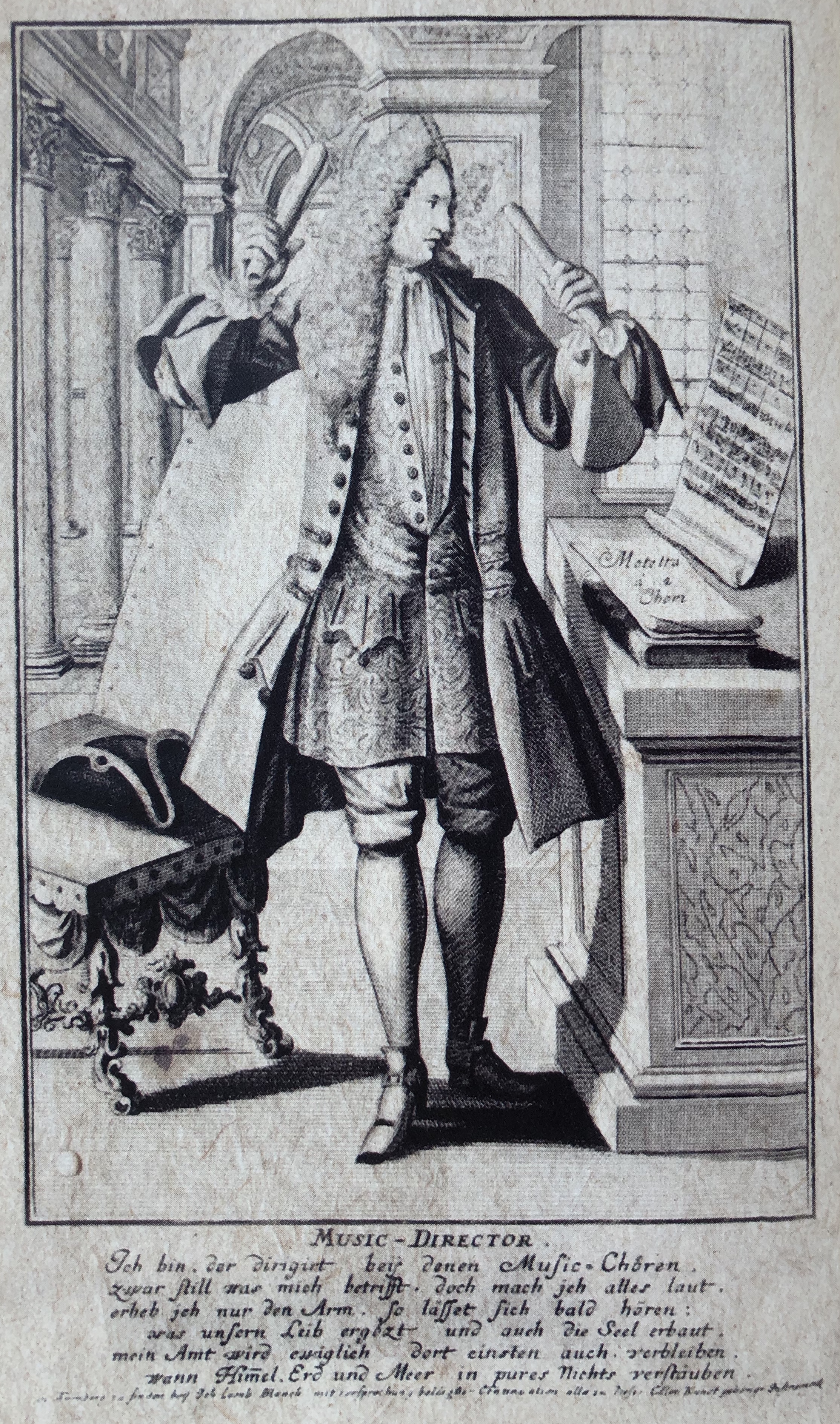
A paper roll called sol-fa has been used to show the time-beat and this technique continued in seventeenth and eighteenth century. It was a popilar practice, shown in such iconographical sources as Musikdirektor with wto paper rolls by Johann Leonard Blanck and Carl Maria von Weber (1786-1826) conducting at Covent Garden in 1826. Ludwig Spohr, the famous composer and violinist who established himself as baton user, but his descriptions of the event performance in 10th April 1820 are not clear14. He was conducting his own second symphony in London at the Philharmonic Society. Performance he described was good and his use of baton was accepted by an audience15. Because Spohr was not a very good piano player, he prefered to wield his violin bow or use a baton.
In Italy the batonwas not acknowledged at all. Until the middle of the nineteenth century the main appointments in the Italian opera were called maestro al cembalo and primo violino capo. Breaking from this tradition Gaspare Spontini (1774-1850) refused to lead his ensemble from the keyboard and began to use baton around 1820, when he became Generalmusikdirector in Berlin16. But it was Angelo Mariani (1821-73) who was most likely the first user of the baton in Italy. An fascinating example of these early musicians batons is held by Galleria Accademia Luigi Cherubini, Florence. It was used by Giuseppe Verdi (1813-1901) on 25th May 1874 when Verdi conducted at La Scala his Requiem, composed in memoriam of Alessandro Manzoni, although the premiere took place three days earlier in Saint Marco Church, Milan. The plain varnished wooden stick is 444 mm long. Another example of the baton used by Verdi during Requiem in London 1879 is depicted in Vanity Fair. August Guckeisen reported about his conducting style: (Verdi) does not merely beat time, he conducts in the fullest sense of the word, he mirrors the musical ideas in his expression, his stance and movement of his baton17.
The history of conducting could be seen as a leadership which is time beating in vocal music (15th-16th century), guiding instrumental ensemble by one of its members (17th-18th century) and era of baton (19th-20th century)18. On the basis of iconographical and literaty evidences and survived historical batons as well we can deduce that at the beginning a conductor's movements were bold and wide and parallel to the body when batonwas held in the middle. Later they changed into lighter form with clear handle what caused more perpendicular movements. Around 1930s batons were made of lighter materials and were more visible for musicians19. Such change is a result of changes within musical performance practice, social circumstances and musical esthetics.
Fans and adversaries
Hector Berlioz (1803-1869), one of the most important theoreticians of the orchestra and orchestration, wrote about superiority of the baton in comparison to violin bow: The orchestral conductor generally uses a small light stick, about 20 inches long (better white than of dark color, for the sake of visibility). He holds it in his right hand and distinctly marks with it in the beginning, the divisions and the close of each bar. Some concertmasters use the violin bow for conducting, but it is less suitable than baton20.
Such twentieth century conductors as Leopold Stokowski, Artur Rodziński, Pierre Boulez are known as not a big fans of the baton. Stokowski (1882-1977) was extremely concerned about final effect of his rehearsals so no wonder he claimed: Whether or not a conductor uses a baton is little importance. Personally I find baton unnecessary - I am convinced that inessentials should be eliminated. But other conductors like to use a baton. If it is of no importance - only the music - its deepest essence - is important21. Artur Rodziński (1892-1958), the assistant of Leopold Stokowski the baton's adversary, was also not in favor of baton even though he occasionally used one. A picture taken in Carnegie Hall, New York in 1940s shows Rodziński holding a baton, probably intended to make clear his conductor's profession. It is significant that the baton carries so many roles and meanings and not all of them are musical.
Arturo Toscanini (1886-1954) one of the most knowledgeable and influential conductors of the twentieth century once said to member of his orchestra: Don't look at the stupid stick in my hand! I don't know myself what it does. But feel - feel what I want. Try to understand!22. Bruno Walter (1876-1962) sees a baton as a very important tool to increase conductor's efficiancy: The baton, extending as it does the obviously restricted beat of bare hand, and magnifying it to distantly visible proportions, provides, in view of the enhanced clarity and plausibility of its movements, a better aid to precise orchestral playing than the empty hand. Every orchestral musician will affirm that he feels much less secure under the guidance of empty hand dispensing mesmerism than under the clear beat of the baton in the conductor's right hand, which thus provides for clarity, while the left effectively looks after dynamic gradations23. Since the contemporary conducting has many ways to indicate different elements of musical performance, it is not necessary to use a stick to be understood by an orchestra or a choir. How conductors express their concept of a performance is a summary of their preferences and personality. For this reasoning contemporary batons are not standardized and, very often, conductors have sets of batons in different lenghts. German musicologist Gustav Becking believed that certain composers have their own fingerprints, co called curves, which conductor can realize and emphasize as he interprets a composer's work in performance24.
Baton
The extraordinary piece of wood called a baton is an evidence of conducting a band or an orchestra. This fact derives from mankind's tendency towards equipping people with artifacts symbolizing power or leadership. The form of a stick or baton as the symbol of power may be found in various shapes: from the royal scepter, speaker's staff and cardinal's stick to an African witch doctor's pole with a nutshell attached. The baton, eventhough it is so strongly rooted in the musical musical culture of mankind, it has numerous connotations both symbolic and functional. The baton is a fascinating artifact that focuses on anthropological questions and the history of musical performance, as well as on the more 'technological' issues, as the availability of such precious materials such as ebony, ivory, tortoise shell, exotic wood, silver gold and different kinds of metal along with such ornamentation techniques as inlaid wood and guilt. In the middle of nineteenth century the practice of using a conductor's stick became very popular. Baton (It. battuta - a beat) in the main partwas usually made of different kinds of polished or varnished ebony. The oldest stick from the Tadeusz Strugała collection [Catalogue: 'Dirigentis Instrumentum. A Collection of Monika & Tadeusz Strugała Batons', Stowarzyszenie im. Ludwiga van Beethovena 2005] which has a cylindrical shape is a typical example of that period (no 1). The batons no 1-3 are ended by bits of ivory which played the role of pointer. The iconographical evidence and the lack of polish in case of baton no 3, shows that batons had been held in the middle. The average lenght of a baton in the middle of nineteenth century ranged between 320 and 370 mm and they were fairly heavy. Later examples in the collection, no 12-17, feature similar designs. Most of them are slightly thinner, made of ebony and have carved ivory endings. The decoration is quite conventional: liras and motifs of acanthus leaves, laurels, panoply with violins, scroll of scores and flutes. These newer batons follow the earlier examples in which bright endings helped musicians follow the conductor's movements.
No 15 is an exceptionally interesting example of baton with an extensive story. A German lady Ludmilla Suoach Gehrecker receeived the baton as a farewell gift from her 'company of shared table' at a restaurant in Hamburg. Frau Ludmilla appears to have been very enterprising; newspaper clips show she had advertised herself as a 'female version of Strauss'. As the conductor of an ensemble called Wiener Walzer, she caused substantial sensation. Press articles invited readers to ask that Frau Gehrecker come and conduct in their city. As a result she performed with orchestras in the best concert halls of England and South Africa. The fact that she traveled so much and performed so extensively demonstrated her extraordinary skills. There was only one rehearsal on the day of performance and how she really performed is unknown since we have no first-hands account. But as a memento of one of her concerts is the baton no 15 that today enriches Tadeusz Strugała's collection. The giving a baton as a present has frequently been seen as a sign of appreciation and thanks for work. Batons that are expressions of gratitude and dedication are no 5, 6, 18, 26, 29, 30, 35, 55 and 61. Baton no 26 is a silent witness of local history in one Parish of St. James in Cardiff, Wales where William Shapland Dobbs Esq. (initials 'W.F. Dobbs' engraved on the silver ring might be a mistake) was awarded in 21st March 1901 with baton by his employer the Reverend D.H. Griffiths and choristers.In these years the parish benefited from prosperity and the choir was of forty-two member choir. The report from St. James Parish Magazine in March 1901 stated25: The other presentation was to our organist. It speaks well for Mr. Dobbs' services, and the esteem in which he is held, that in less than a year the men under his training and leadership should express their appreciation of his work and unfailing courtesy in so unmistakable a manner. The presentation which was kept a secret came upon him as a great surprise, and consisted of an exquisite ivory baton elaborately carved and mounted in silver.
Male and female choral societies in 19th century Europe (including Poland, which at that time and for over a century, did not exist on the map at all) were very popular and fitted the needs of amateurs for making music. Playing in military bands in the 19th century was another kind of music activity. Shapes of those batons are designed in a similar way. A fairly typical design element is an image of a lira (catalogue no 9, 10) and laurels on the very top (no 9, 7). Batons used in military bands were slightly longer than symphonic or choral ones. The stick no 20 belongs to the latter kind. Beneath a silver ring on the baton was a hidden tuning reed device that simplified the giving of a proper tone to the choir singers before starting.
Materials in nineteenth and early twentieth century batons for daily use and dedications were made of precious materials. Ebony, as mentioned above, prevailed. Ornaments, often made of silver, capped the black ebony stick. A beautiful example of good craftsmanship is the baton noted in this catalogue as numer 11. It features, the best quality ebony and a homogeneous structure and color. Apart from that, the top end features lira and the handle has pictures of small angels with rebec and Pan pipe. Special attention should be paid to the highly detailed ornaments in the panoply. One unique in its kind of baton is an English stick mentioned above as coming from St. James Church, Cardiff, Wales. It is an example of relatively long baton which appeared at the beginning of the twentieth century. More conventional batons are examples 18, 19 which have simple, cylindrical shapes and cloves' inlaid on both tips. Mother-of-pearl is also often used in variety of designs; especially little dots whichcreate a shimmering effect (catalogue no 20, 21, 22, 23, 40, 42 and 61). Another decoration is a silver band around the stick, a reinforcement, which is useful for impulsive conductors who use the baton to beat the conductor's stand rather than showing measure or tempo (see baton no 49). A beautiful ebony baton with silver endings of Art Deco design (no 27) was definitely used by an energetic conductor too, as the middle ring bears sign of beats. Metal bands could also be placed so that inscriptions could be engraved. Natural wooden patterns could be a decoration in itself as in the case of baton no 25 with guilt-plated, silver endings. Conical stick no 38 shows a jeweler's craft with its precision, precious materials and ornamentation. On the basis of the paper label fromthe baton's case we might assume that it was made by Władysław Glixelli famous goldsmith in Kraków. The main part of the baton is tortoise shell with a gilt-plated, silver handle and beautiful garlands covered with green enamel that create a unique and marvelous design. Batons can be also souvenirs as for instance no 54 presented by Arturo Toscanini to Chech soprano Jarmila Novotna (1907-1994). He invited her in 1939to perform in The Metropolitan Opera, New York and she continued until 1956. Baton no 9 has been made as a memento of Custozza battle in 1866 during Austro-Prussian war called Seven Weeks War. Tadeusz Strugała's collection is the representation of the evolution of a very inconspicuous object - the baton.
Cylindrical, short and heavy batons exemplify thebeginning of the baton, later ones lead to enhance ensemble directing, without wasting energy. At first batons had no handle and were held in the middle (baton no 3) but later batons had a clear top, bottom and handle. We can distinguish four kinds of batons: cylindrical, conical with narrow part in the middle that ergonomically adapted to conductor's hand, conical with handle marked off and contemporary thin and light batons. The first two groups impose the 'parallel-to-the body' way of conducting. But only batons with separate handles impose 'perpendicular-to-the-body' baton-holding thatrequire mostly the use of the palm of the hand and not entire arm during conducting.
In 1908 Władysław Rzepko (1854-1932), viola player, composer and conductor and founder of singing society calle 'Lutnia' as well, provided a very interesting summary about the baton: The task of the hand equipped with a stick is leading the whole ensemble. It shows tzct measure, tempo changes, and because of such an important role it is very important to know the rules of hilding and movements of the stick, which had been applied by educated conductor. There are two kinds of grips. Forst, more common here, the grip from bottom part (in this case the baton should be shorter) and second, the grip nearly in the middle of the stick. The stick should have clearly signified contours of the signs and because of that the stick movements should be done solely by forearm and not by fist, because in case of fist movements musicians (similarly when too long stick is used) are not able to see contours. As described above to grip in the middle is better (Castagneri, Reinecke and others). In that very grip each movement of the stick isperceptible and it is necessary to remembe that smaller movements should prevail in comparison to broader movements26.
In the 1942, a British conductor Rudolph Dolmetsch, a son of Arnold known for the performance on historical instruments, meticulously analyzed how one must select a baton for himself27. In his opinion, the proper baton for a conductor was as essential as a good bow for a violin player. He strongly recommended personal adjustments analogue to an oboist's adjustment of the reed. Dolmetsch was not forgetting stricte physiological aspects such as the sweating of the hand, and because of that, he advised the use of batons with a handle cork. He felt the length of the baton should be the conductor's choice.
Contemporary batons are no longer full of ornamentations or inscriptions. Their main purpose is to assure comfortable conditions when used. As in the case of each kind of instrument, today's batons have different lengths as well depending on the ensemble size and personal preferences of the conductor. Batons today may have various sizes but most have the same general diameter. The handle is generally made of wood, sometimes of a very special kind for instance ziricote wood28 used in baton's handle no 56. In relation to the ensemble size and personal preferences of the conductor, batons today may have various sizes but more or less the same diameter. The handle is sometimes simply a swelling of the wood but also could be a bit of rubber or cork. Typically the stick are made of bright colors which help musicians follow the movements of the baton. The very thin baton (no 45) is an example of one that is covered by a layer of white silicon, which makes it more elastic and resistant to fracture. It is customary that the baton is held in right hand between thumb, index finger and middle finger, although there are also left-handed conductors.
Many people were helpful with their suggestions and comments on various stages of the work. I would like to express my gratitude especially to Tadeusz Czechak, Gabriele Rossi Rognoni, Rev. Keith Kimber, Quincy Whitney and Leslie Wayne.
Alicja Knast
2005, Stowarzyszenie im. Ludwiga van Beethovena
Catalogue: Dirigentis Instrumentum. A Collection of Monika & Tadeusz Strugała Batons
1. P. Murchard. "Discovery of Ancient Greek Tables Relative to Music". Harmonicon 3 (1925): 56, 76 after: Elliot W. Galkin. A history of conducting: in theory and practice. New York: Pendragon Press, 1988. 245, 487-8.
2. Gregorius, Reisch. Margarita philosophic. [Freiburg im Breisgau]: Chalchographatum primiciali hac pressura Frigurgi p [er] ioanne [m] Schottu [m] Argen [toraci]., Citra festu [m] Margarethe anno gratiae M.CCCCC.III (19 July 1503) 1503
3. Bermudo Joan. Comiença el libro lamado declaración de instrumentos musicales. Ossuna: Iuan de Leo 1549 after: Spitzner, John and Neal Zaslaw. "Conducting". The New Grove Dictionary of Music & Musicians 2nd Edition. Ed. Stanley Sadie, John Tyrrel. Vol. 6. London: Macmillan Press, 2000. 260-275
4. Mersenne Marin, Harmonie Universelle, contenant la Teorie et la pratique de la Musique, Paris: 1636.
5. Charlton David. "' A maître d'orchestre... conducts': New and Old Evidence on French Practice". Early Music 21 (1993): 341-53.
6. Spitzer, John and Neal Zaslaw. The Birth of the Orchestra. History of an Institution, 1650-1815. Oxford: University Press, 2004. 73.
7. Félibien, André. Relation de la fête de Versailles du dix-huit juillet mille six cent soixante-huit; Les divertissements de Versailles doneés par le Roi. Paris: Editions Dédale, Maisonneuve et Larose, 1994.
8. Cairns David. "French Tradition". The Cambridge Companion to Conducting. Ed. José Bowen. Cambridge: University Press, 2003. 134.
9. Mattheson Johannes. Das vollkmmene Capellmeister. Transl. Ernest C. Harriss, Ann Arbor, Mich: UMI Research Press, c1981.
10. Zaslaw Neal. Mozart's symphonies: context, performance practice, reception. Oxford: University Press, 1989. 508.
11. A. Tessier. "Correspondance d'Andre Cardinal des Touches et du Prince Antoine 1er de Monaco (1709-1731)" La revue musicale 8 (1926-7), issue 4: 113.
12. Rousseau, Jean Jacques. Dictionnaire de musique. Paris: Veuve Duchesne, 1786. 49-50.
13. Bach Carl Emanuel. Versuch über die wahre Art das Clavier ze spielen. Transl. William J. Mitchell. New York: WW. Norton, 1949. 34-5.
14. Jacobs, Arthur. "Spohr and the Baton", Music and Lettres 21/4 (1950). 307.
15. Spohr, Ludwig. Autobiography. Vol. 2nd. Transl. Anon. London: Longman and Green, 1685. 82-3.
16. Rose, Micahel. "The Italian tradition". The Cambridge Companion to Conducting. Ed. José Bowen. Cambridge: University Press, 2003. 151.
17. Conati, Marcello. Interviews and Encounters with Verdi. London: Gollancz, 1984. 1.
18. Spitzner, John and Leal Zaslaw. "Conducting". The New Grove Dictionary of Music & Musicians 2nd Edition. Ed. Stanley Sadie, John Tyrrel. Vol 6. London: Macmillan Press, 2001. 260.
19. One of the last references found so far about heavy, ebony baton: Schmid, Adolf. The Language of the Baton. New York: G. Schirmer Inc., 1937. Plate 1.
20. Bamberger, Carl ed.The Conductor's Art. New York: Columbia University Press, c1989. 28.
21. Bamberger, Carl ed.The Conductor's Art. New York: Columbia University Press, c1989. 200.
22. Bamberger, Carl ed.The Conductor's Art. New York: Columbia University Press, c1989. 310.
23. Bamberger, Carl ed.The Conductor's Art. New York: Columbia University Press, c1989. 164.
24. Nettheim, Nigel. "How Musical Rhythm Reveals Human Attitudes: Gustav Becking's Theory", International Review of the Aesthetics and Sociology of Music, Vol. 27/2 (1996). 101-122.
25. I would like to express my deepest gratitude to Revd. Keith Kimber for information concerning St. James Parish, Cardiff.
26. Rzepko, Władysław. Muzyk jako przewodnik zespołów (dyrektor). Warszawa: Geberhner & Wolff, 1908. 6-7.
27. Domletsch, Rudolph. The Art of Orchestral Conducting. London: Bosworth & Co, 1942.
29. Wood originate from Mexico and South America. Beautiful flecks on quarter sawn surface. Hard and heavy. Holds its place well in service. Hard, yet easy to work and takes a high polish.
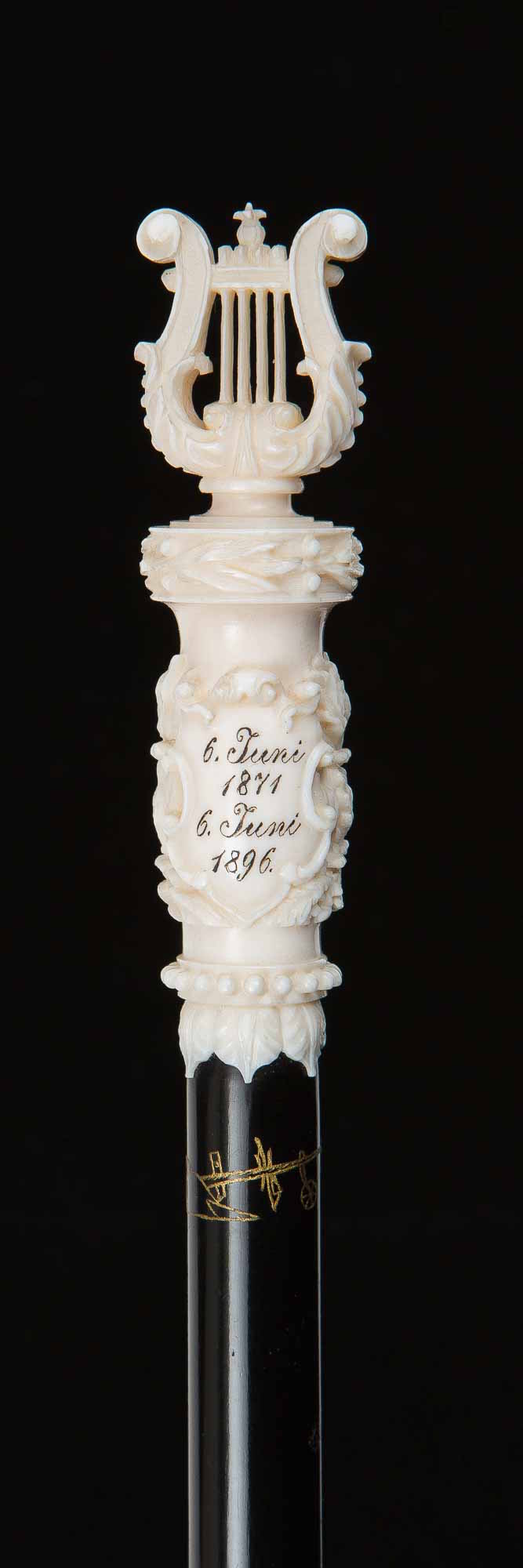
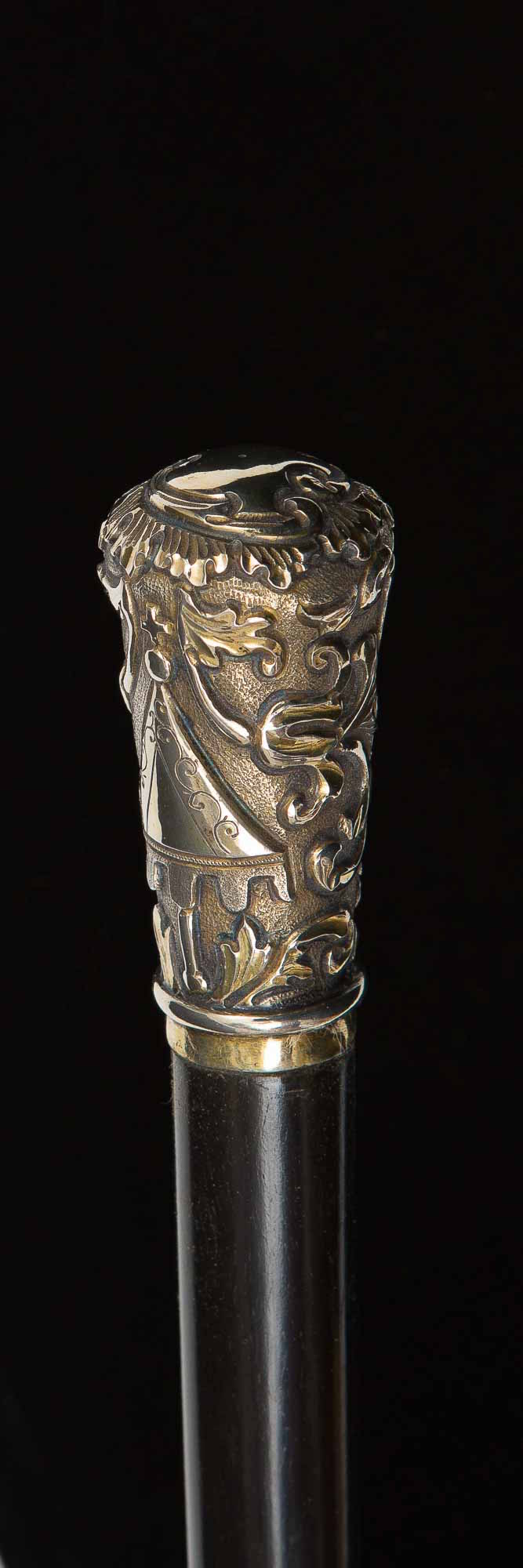
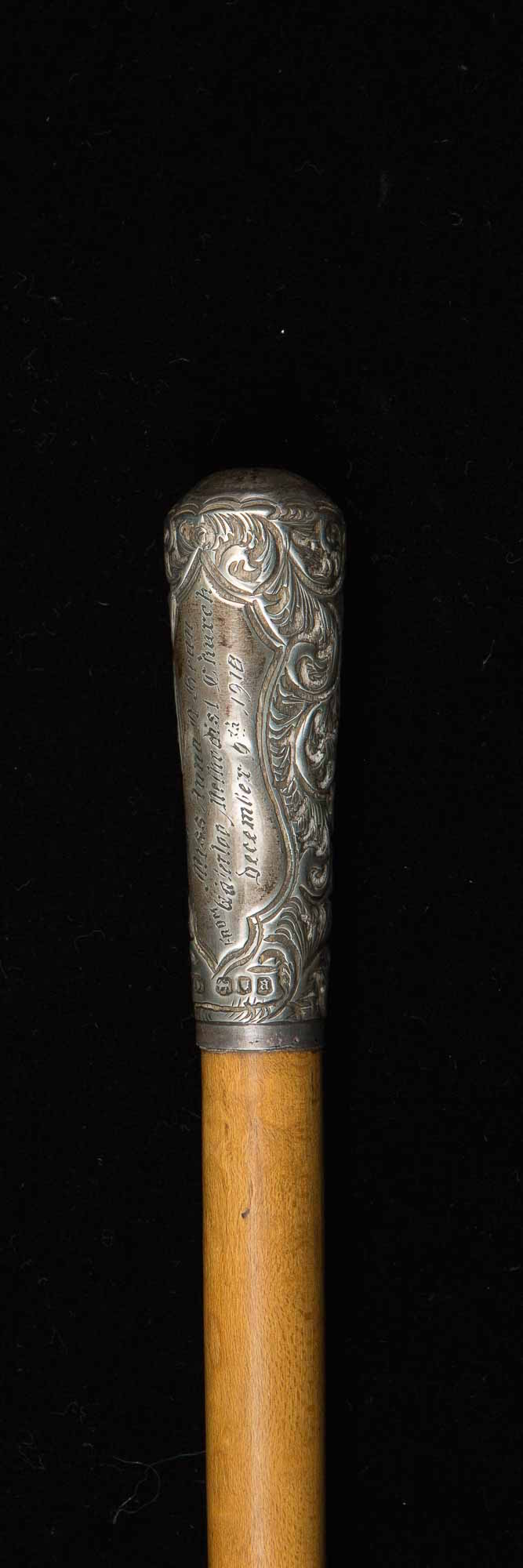
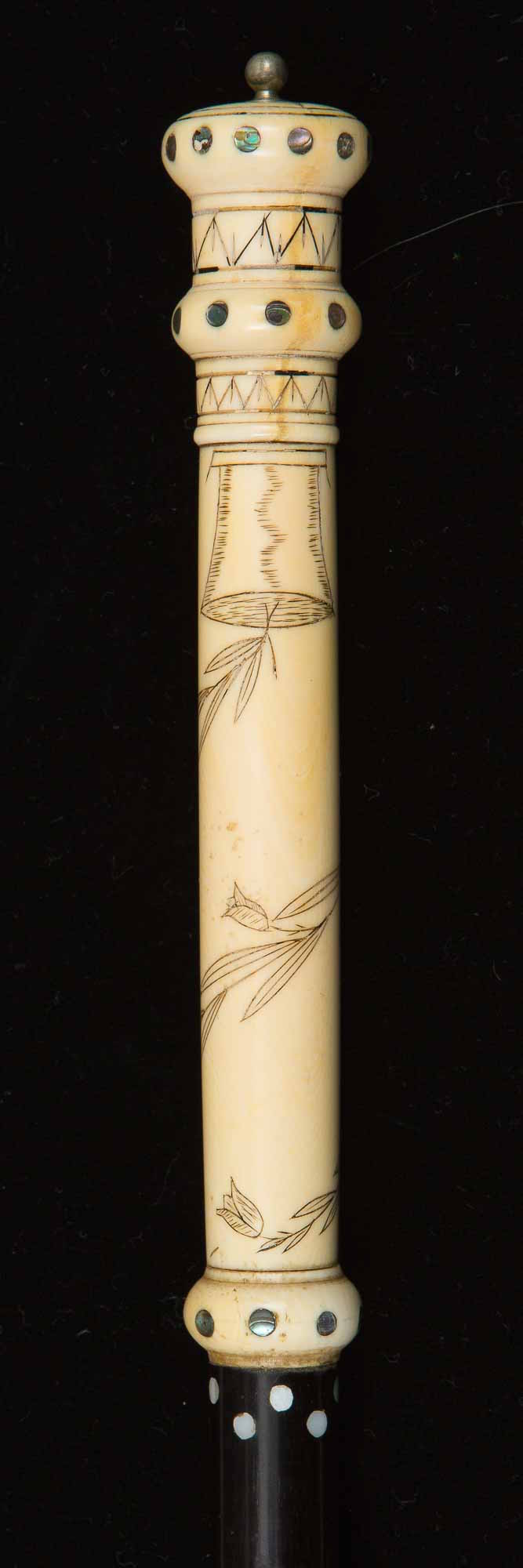
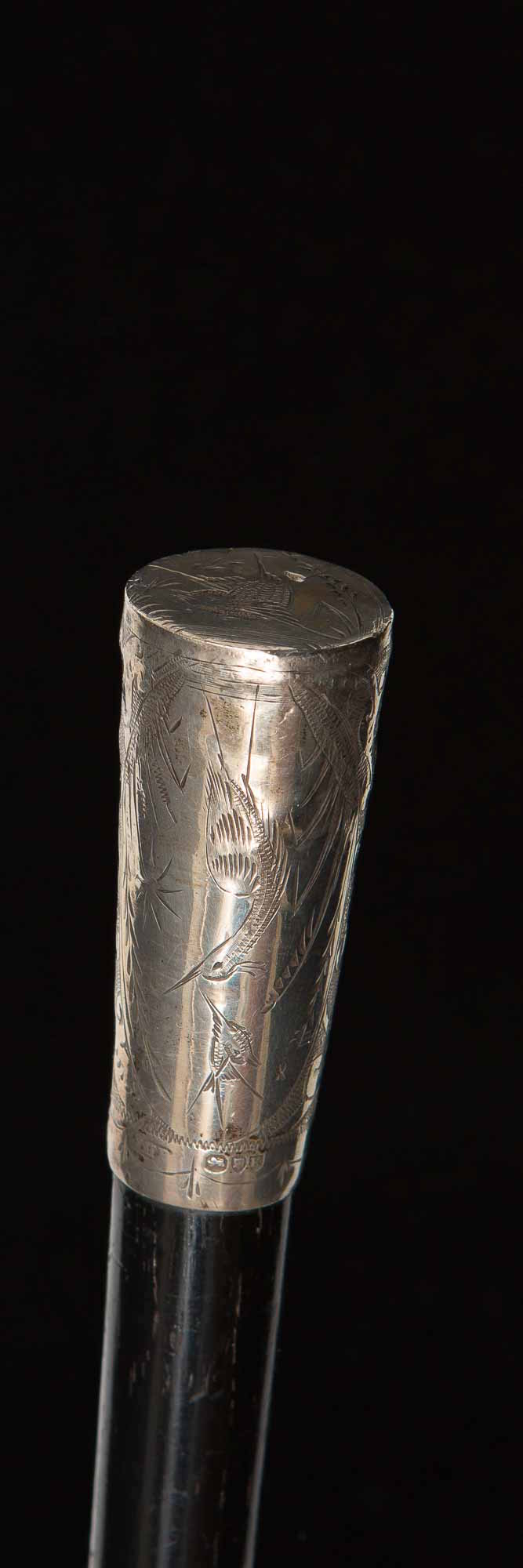
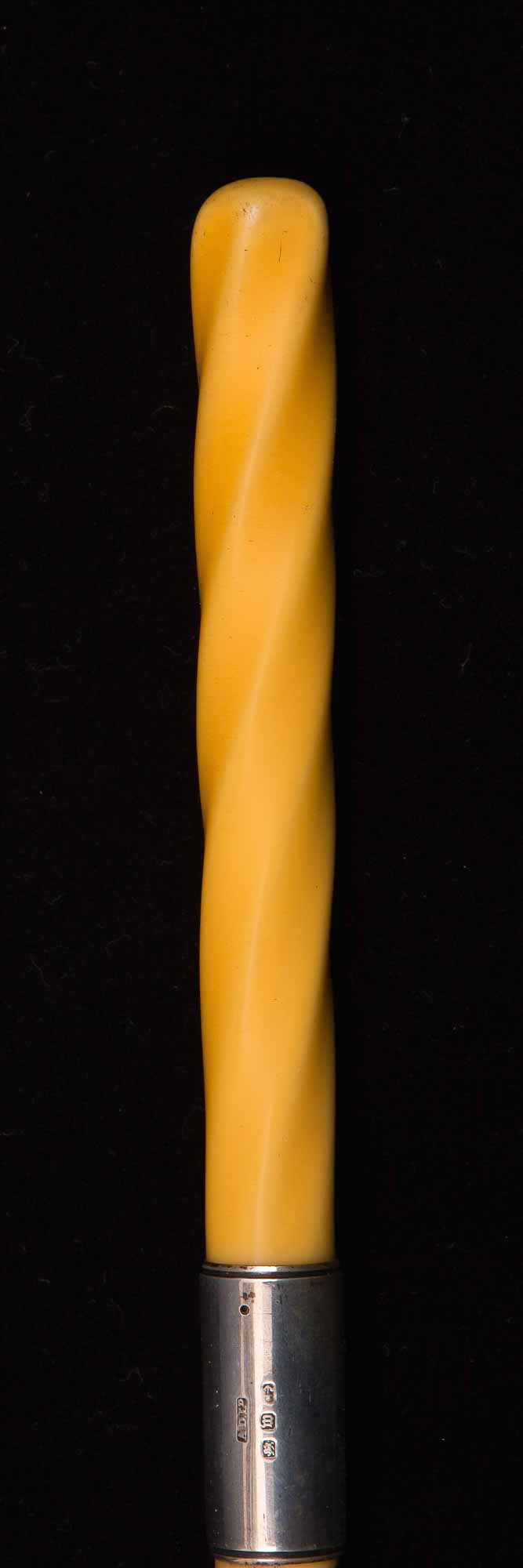

Jan Stanisław WItkiewicz's collection, photo: Waldemar Kielichowski © Institute of Music and Dance, Warsaw



